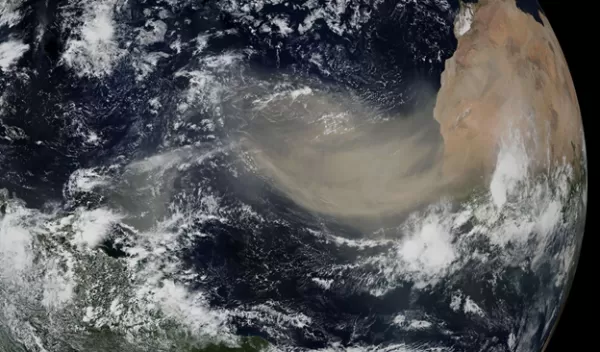
Increased atmospheric dust is masking greenhouse gases' warming effect
A new study shows that global atmospheric dust — microscopic airborne particles from desert dust storms — has a slight overall cooling effect on the planet that has hidden the full amount of warming caused by greenhouse gases.
The U.S. National Science Foundation-supported research, published in Nature Reviews Earth and Environment, found that the amount of desert dust has grown roughly 55% since the mid-1800s, which increased the dust's cooling effect.
"In addition to illustrating the complexity of the climate system, this study raises the alarm that proper accounting of atmospheric dusts in climate models is more important than ever in our assessment of future climate scenarios," said Varavut Limpasuvan, a program director in NSF's Division of Atmospheric and Geospace Sciences.
The study is the first to demonstrate the overall cooling effect of atmospheric desert dust. Some effects of atmospheric dust warm the planet, but because other effects of dust counteract warming — for example by scattering sunlight back into space and dissipating high clouds that warm the planet — the study calculated that dust's overall effect is a cooling one.
Should dust levels decline — or stop increasing — warming could ramp up, said UCLA atmospheric physicist Jasper Kok, the study's lead author.
"We show that desert dust has increased, and most likely slightly counteracted greenhouse warming, which is missing from current climate models," said Kok, who studies how particulate matter affects the climate. "The increased dust hasn't caused a lot of cooling — the climate models are still close — but our findings imply that greenhouses gases alone could cause even more climate warming than models currently predict," he said.
Kok compared the revelation to discovering, while driving a car at high speed, that the vehicle's emergency brake had been partly engaged. Just as fully releasing the break could cause the car to move faster, a stop to the increase in dust levels could slightly speed up global warming.
And while atmospheric desert dust levels have increased overall since pre-industrial times, the trend has not been steady — there have been upticks and declines along the way. Because there are so many natural and human-influenced variables that can cause dust levels to increase or decrease, scientists cannot accurately project how the amounts of atmospheric dust will change in the coming decades.
Dust can increase because of drier soils, higher wind speed and human land-use changes like diverting water for irrigation and turning marginal desert regions into grazing and agricultural land. The factors that account for increased dust levels are not clear-cut or linear, and whether the amounts of desert particulates will increase, decrease or remain relatively flat is unknown.
While the increase in atmospheric dust has somewhat masked the full potential of greenhouse gases to warm the climate, Kok said, the findings don't show that climate models are incorrect.
